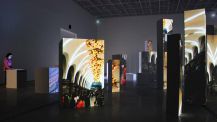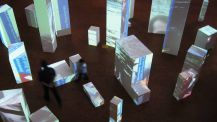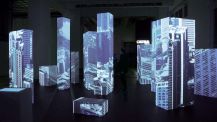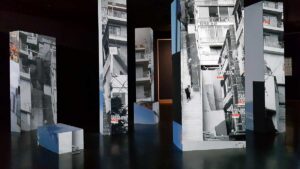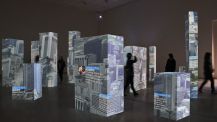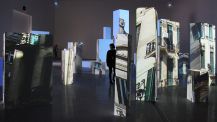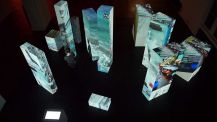Interactive Net-Based Installation
10.000 Moving Cities – Same but Different focuses on how places are constantly changing and cities are becoming more and more similar. Places are emerging that could be anywhere in the world without a real local identity. This process is accelerated by technological progress, fast means of transport and communication, and the Internet. Visitors can select any city or location via a digital interface. The Internet is searched in real time for the latest text, image, video and sound information about the chosen location. Four projectors and eight audio speakers project the results into the space. Visitors can walk through the model and experience the information in 3D.
Attracted and inspired by images, sound, text and video, visitors explore the cities and perceive fragments of the immense amount of data. In addition, the audio and visuals are constantly changing, never the same, always in movement, like the place itself. Just as every city in the world is different, so different and alive appear the projections and sounds. Each new request creates new representations of the real world as a combination of visitors and digital matrix. In this sense, the artwork explores how globalisation creates “places without a local identity” – as described in Marc Augé’s essay Non-Lieux (1992) –, and stimulates a reflective attitude leant on a novel “immersive confrontation” with the digital society of our time.
User-generated content is the source of audiovisual information that is neither censored nor selected by a particular community, but rather produced by the public, including visitors. Each request allows us to join and actively participate in the social movements of our time.
10.000 Moving Cities – Same but Different (Version 4), FT Madrid
2023/2024 (Version 5)
10 x 10 x 5m (WDH)
14 cubes in different sizes
10.000 Moving Cities – Same but Different (Version 3), MAK Vienna
2017/2018 (Version 3)
10 x 8 x 7m (WDH)
20 cubes in different sizes
10.000 Moving Cities – Same but Different (Version 2), MMCA Seoul
2013/2014 (Version 2)
22 x 14 x 7m (WDH)
30 cubes in different sizes
10.000 Moving Cities – Same but Different (Version 1), ZKM Karlsruhe
2010/2011 (Version 1)
16 x 16 x 8m (WDH)
30 cubes in different sizes
Interface
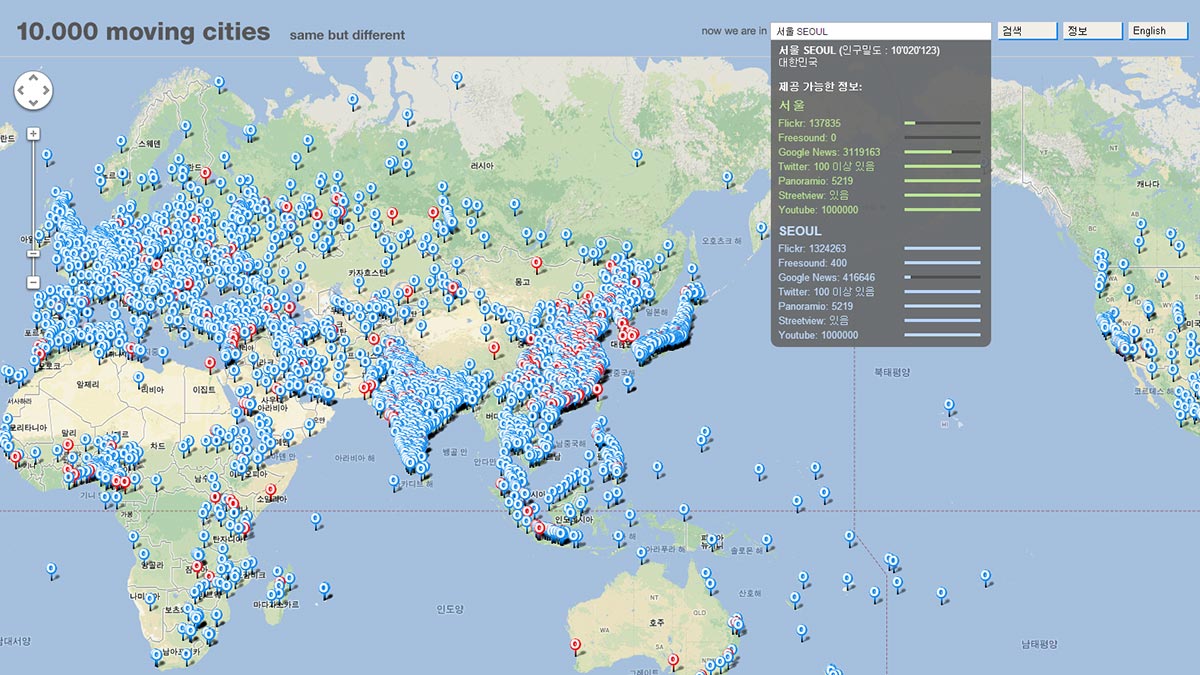
Cities can be clicked or searched using the on-screen keyboard.
Visitors can search for cities and towns in two different ways. The first option involves choosing a city by sliding the mouse arrow across the map and clicking on a pre-existing blue or red pin. The mouse wheel enables visitors to zoom in and out of the map. The second option involves clicking on “Search” and inserting the name of a city via the keyboard on the screen, then clicking on “go!”.
Through this work you will be able to discover cities you’ve never even heard of before. In China alone, there are over 100 cities with over one million inhabitants (marked in red). We would like to give you the opportunity to discover these and 10.000 other places through a multi-media experience.
Masks

The precise projection can be adjusted by the software, using adjustable masks.
Thus, only the cubes are projected, not the floor. This gives the impression that the objects themselves radiate the image.
